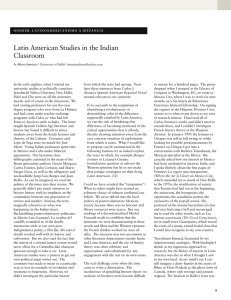The Baroque andCarlos Fuente`s Zona sagrada
Anuncio
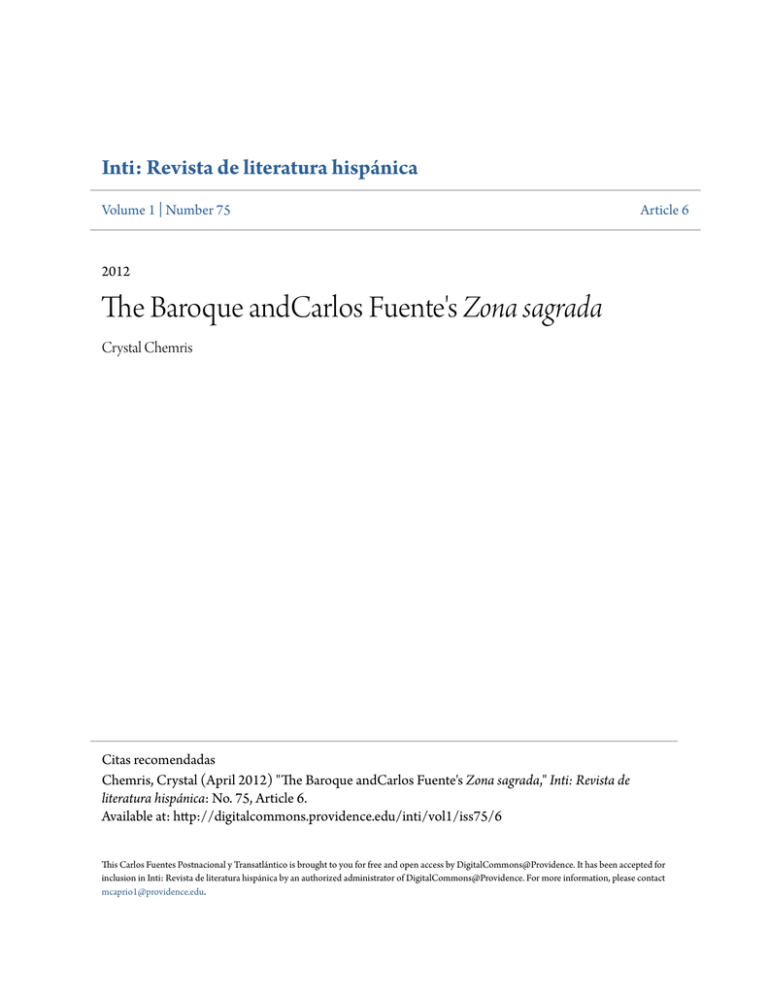
Inti: Revista de literatura hispánica Volume 1 | Number 75 Article 6 2012 The Baroque andCarlos Fuente's Zona sagrada Crystal Chemris Citas recomendadas Chemris, Crystal (April 2012) "The Baroque andCarlos Fuente's Zona sagrada," Inti: Revista de literatura hispánica: No. 75, Article 6. Available at: http://digitalcommons.providence.edu/inti/vol1/iss75/6 This Carlos Fuentes Postnacional y Transatlántico is brought to you for free and open access by DigitalCommons@Providence. It has been accepted for inclusion in Inti: Revista de literatura hispánica by an authorized administrator of DigitalCommons@Providence. For more information, please contact [email protected]. ­­THE BAROQUE AND CARLOS FUENTES’S ZONA SAGRADA Crystal Chemris University of Oregon Z ona sagrada, published in 1967, is Carlos Fuentes’s venture into the new Latin American mythic novel. Fuentes himself describes the novel’s newfound fields of inspiration: “al inventar o recuperar una mitología, la novela se acerca cada vez más a la poesía y a la antropología” (qtd. in Avellaneda 247). Film is also an acknowledged influence, the novel having begun as a film script in which María Félix and her son were to play themselves (Oviedo 30). Fuentes cites Buñuel as a model of mixing the ludic and the serious to achieve his own artistic goal of “una politización del juego” (Rodríguez Monegal 54). Yet the experimental novelty of the work may have undermined its appeal. René Jara, among others, faulted the work for falling into “un virtuosismo técnico que paraliza la vitalidad del mundo narrado” (170). Severo Sarduy, in his classic essay, written shortly after the publication of Zona sagrada, “Un fetiche de cachemira gris perla” (1968), reads the work as an oedipal drama of mother and son: a film star Claudia Nervo, cast as an emblem of México, and her son Guillermo, nicknamed, significantly, Mito. A novel about the process of its own composition, a parody of intertwined versions of the Odyssey, the work, in his view, transforms its central images into a play of signs: the mother’s face as an iconic close-up, “un rostro tótem,” the mirror of which she deprived her son in her own narcissism, her clothing embraced instead by him as a fetish, which like every other figure in the work becomes emptied out of any transcendent signification. Sarduy’s early intervention lays the foundation for future critical studies, of which I will mention two that define poles of inquiry.1 Steven Boldy reads the novel as a “dizzying theatre of representation” that combines “bits and pieces from a pre-existing code into a new configuration” as “an instance of 47 the bricolage” celebrated in the work of Claude Lévi-Strauss (181, 183). He notes the jumble of high and low intertextual references not only to literary but also to visual works in this mix: paintings, pin-ups, religious images, frescos, movies (181). For Boldy, this free play of reversible and self-referential chains of signification proliferates to form a work whose difficulty—in the spirit of Sontag and Robbe-Grillet—resists interpretation. In contrast, Suzanne Jill Levine elaborates a political reading, citing a parallel with Pedro Páramo in the topos of an unfinished odyssey—with a double oedipal twist—that points to the unresolved legacy of the Mexican Revolution. For Levine, Claudia Nervo, who once played a soldadera, embodies the betrayal of the revolution; she symbolizes the false façade of consumer culture and the economic submission of her people to the United States. These two contrasting readings return us to Fuentes’s formula: “una politización del juego.” Zona sagrada’s textual play has been described rather cursorily as Baroque, but at first blush the work does not seem to be a Neobaroque novel in the mold of, for example, Terra Nostra. There is no obvious Baroque hypotext, or substantive contextualization in the early modern.2 Yet if one measures the text against Severo Sarduy’s definition of Baroque form, articulated most systematically in his essay “El barroco y el neobarroco” (1972), Zona sagrada clearly fits the label. I hesitate, however, to apply a purely formal definition of Baroque, bearing in mind Francisco A. Ortega’s argument that “The baroque preserves its recurring naming capacity in Latin America not because of what it positively signifies but because in its many misnomers it marks a field of struggle over the meaning and legacies of our modernity” (188). With that caveat, I will proceed to address the Baroque features of Zona sagrada, first in formal terms using Sarduy’s vocabulary, but then also as part of a vexed political-historical construct. In so doing, I will include what might be called cases of Baroque prequels (Celestina, Lazarillo) and sequels (Modernismo, Symbolism) that share certain “syntagmatic grama,” to use Sarduy’s term, with Zona sagrada: in other words, a type of syntax or scaffolding that defines a more subtle form of intertextuality. My hope is to contextualize this exploration of Baroque features in Zona sagrada within an analysis of the role of violence and sexual politics as features of the crisis of modernity. To do this, I will need to first reference what I believe is an important and as yet (as far as I know) unacknowledged source for this work: Leopold Von Sacher-Masoch’s original novel of sadomasochism, Venus in Furs (Venus im Pelz 1870) as it was mediated by yet another intertext, Kafka’s Metamorphosis (1915-18). I rely on Mark M. Anderson’s discovery of the role of Venus in Furs in Kafka’s story to make my case. Kafka’s Metamorphosis opens with an ekphrastic description of a framed picture of a cut out from a magazine—a lady with a fur cap and stole holding out “a huge fur muff into which her whole forearm had vanished”(89), a picture against which Gregor, who had awoken to find himself transformed into a 48 INTI NO 75-76 cockroach, would enjoy resting on. In Kafka’s text, Gregor “presses himself to the glass, which was a good surface to hold on to and comforted his hot belly” (118; qtd. in Anderson 124). As Anderson points out, Kafka takes the basic situation of Venus in Furs, announced by the “visual cue” of the appearance of the picture, playfully suggestive of the vagina dentata, and inserts it into Gregor’s oedipally-charged family life (125). Sacher-Masoch’s novel includes a similar scene before a photo of a “Venus in Furs,” modeling the ekphrastic doubling of Fuentes’s novel, with pornography itself operating as a visual fetish. The photo depicts a nude woman in furs, playing with a lash, her bare feet resting on a man lying slavishly like a dog. In his face “lay a brooding melancholy and passionate devotion; he looked up to her with the ecstatic burning eye of a martyr” (trans. Fernanda Savage; qtd. in Anderson 121). Sacher-Masoch’s use of religious imagery here brings to mind Catherine Marshall’s observation that vestiges of the masochism associated with early modern religious fervor resurface in modern sadomasochistic sexual practices (115, 121). This is quite germane to Zona sagrada’s play with the boundaries of the secular and the sacred. The ending of Sacher-Masoch’s novel informs that of Fuentes as well, in the appearance of a male partner of the dominatrix, named Apollo (an obvious source for Giancarlo), who emerges from her bed to whip the masochistic protagonist. Mito’s final debasement, as Charlene Helmuth notes, mirrors Kafka’s Metamorphosis in his transformation into a servile dog (36).3 The use of a pornographic subtext as a vehicle for social critique is as old as the Celestina and Lazarillo and as modern as the work of Darío and Fuentes, as each engage elements of erotic debasement within a secularization of religion in art. In linking these Baroque prequels and sequels, I take inspiration from “Cervantes, or the Critique of Reading” (rev. 1988), in which Fuentes questions the facile teleology that would assign a date to Spanish modernity. I will also note that while there are pivotal moments in the ebb and flow of combined and uneven development that constitutes the scope of history, their impact on letters cannot be established in a simple or direct correspondence. Nonetheless, the contradictory figures associated with critical junctures in Hispanic modernity do constitute a kind of grammar of the literary Baroque—to use Sarduy’s term—and one that we can trace in a brief genealogy of works that constitute a structural heritage of Zona sagrada. My focus, again, will be on a less apparent case in Sarduy’s taxonomy, that which illustrates a similar syntax or scaffolding without necessarily demonstrating overt examples of direct intertextuality, and I will rely on the current critical consensus on the works at issue to make my argument. Roberto González Echevarría, with good reason, titles his investigation into modern Latin American continuities of the Spanish literary Baroque Celestina’s Brood, as he considers the Celestina (1499), often placed in the medieval canon, to be one of the great “literary myths” of the Spanish Golden Age, one which is seen to have “opened the dark abyss of modernity” (31, 11). The features of CRYSTAL CHEMRIS 49 Baroque syntax in the Celestina include the parodic incorporation of previous literature,4 both classical and European, amounting to a debasement of the epic in its aspiration to inclusivity; the “staging” or ironic realization of literary topoi, in this case the commonplaces of courtly love poetry;5 and a bleak “axiological nihilism,” to use Stephen Gilman’s term, in its chaotic enumeration and leveling of a list of events both personal and political as all equally insignificant before the cosmic indifference of the new space.6 Most pertinent to Zona sagrada is its play with the boundary of secular and sacred, in its defamiliarization of the code of courtly love through its association with prostitution. The masochistic subservience of the courtly lover,7 modeled on the cult of the Virgin, inverted and obscured the degradation of woman in feudal society. In its critique of the commercial nature of all sexual relations, the Celestina exposes the entire social hierarchy from the perspective of an alienated converso writer. Lazarillo de Tormes (c.1554), written in the aftermath of the defeat of the Comuneros and in the context of the Church debates on the fate of the new urban poor, figures its social critique as well in a recognized debasement of the archive of sacred and secular literature.8 Like Zona sagrada, it operates on the basis of what Edmond Cros calls an endless dynamic of inversionsm,9 a circulation of reversible signs that parallels the circulation of human labor, now reduced—as Marxist critics have observed—to a replaceable commodity on the market.10 This commodity fetishism is associated with Eucharistic imagery in what is seen as a covert but scathing indictment of the endless cycles of prostitution and corruption protected by the clergy, including the violent sexual abuse of children such as Lazarillo (e.g. Rabell, Ferro). The story of Lazarillo mimics Biblical narrative in its recognized use of figura (Deyermond), trumpeting the ending from the beginning in what could well be seen as a model for Fuentes’s positioning of the culmination of his narrative in the first chapter, ironically titled “Happily Ever After.” In such a debasement of Christian eschatology, Lazarillo de Tormes becomes a degraded, secularized version of the peregrinatio vitae topos, a circular journey of social frustration and historical impasse.11 Here Zona sagrada conforms to its early modern model within the primary syntagmatic grama Sarduy describes, that of the category “escritura/Odisea” announced in the negative, the happy end both its apotheosis and its own mockery (1401).12 The more experimental works of the Baroque proper continue this pattern. Cervantes’s Don Quijote (1605-15) also illustrates the syntagmatic grama of “escritura/Odisea,” repeatedly splitting into doubles, miniatures of itself,13 and enacting its own process as writing. Zona sagrada imitates this in Mito’s selfdescribed narration, referencing an apocryphal version of the Ulysses myth. Fuentes’s novel stages a debased, dark side of Don Quijote’s madness in Mito’s solipsistic compulsion to view the world entirely through the mediation of art (See Gyurko, “Sacred and Profane” 190). A work like Góngora’s Soledades is yet another case. The poem depicts an inconclusive pilgrimage, a debasement of epic, in a bricolage of classical and Renaissance forms emptied out of their 50 INTI NO 75-76 canonical significance (Beverley, Aspects 106; Collard 102). Most significantly, it does this within framing images of aestheticized sexual violence, emblematic of imperial conquest (Chemris, “Violence, Eros”). I will mention briefly modernismo in association with Symbolism as Baroque sequels. Sarduy has pointed to Mito’s “zona sagrada” as “una gruta rubendariana,” displaying a proliferation of cultural artifacts, “este cáncer barroco” (31), and notes references to Beardsley’s Salomé (30). Boldy has identified further ekphrastic and literary citations to Decadent art. But what I find most striking about Fuentes’s incorporation of modernismo is his staging or ironic realization of the modernista and Symbolist goal of a religion of art, which Gyurko describes in the personal credo of Mito. The novel also realizes the modernista incorporation of aristocratic privilege in the private sphere, referenced in the dialogue about the “derecho de la pernada” (115) in a modern day brothel, and implies a continuity with the bohemian world of sexuality associated with Symbolism. Given Fuentes’s dedication of the novel to Paz and his own comments on sources for the new mythic novel, I suspect that Fuentes investigates in narrative the very Symbolist continuity of the Baroque that Paz explores in poetry: for example, in an enactment of the solipsistic poetics of José Gorostiza’s Muerte sin fin, the aspiration of the poet as godlike and collapsing as a form of evolutionary or embryonic regression. Here we see a confluence of the modern antihumanism Boldy observes with the Baroque fear of loss of self, represented by Fuentes in the earlier frescoes of Signorelli. More obvious is the representation in Zona sagrada of the aspiration of the Symbolist poet to watch himself write, to observe his own creation, depicted in Claudia’s zeal to watch her own movies.14 Lanin Gyurko has noted an indigenous aspect to Claudia’s solipsistic fascination with her own image in her association with Tezcatlipoca, whose attribute was the smoky mirror (“Pseudo-Liberated Woman” 30; cf. Durán, “Holy Place” 82-86). Paz describes the structure of La muerte de Artemio Cruz in terms that recall the dynamics—and crisis—of Symbolist aesthetics, the evocation of the possibilities of the poetic word on the edge of its negation. In Paz’s view, the various selves of Cruz’s past converge simultaneously in his death agony: “el viejo agonizante busca en su vida pasada el indicio de lo que es verdaderamente, ese momento inmaculado que le permitirá ver de cara a la muerte...Cruz muere indescifrado...su muerte nos enfrenta a otro jeroglífico, que es la suma de todo lo que fue—y su negación” (Giacoman 19). A similar dynamic informs Zona sagrada, in its indeterminate shuffling of historical possibility, its “juego de naipes” that represents, enigmatically, the cipher of a new social order. In his bricolage of myths of right and justice, engaging, implicitly, the classical heritage of predecessors such as Reyes, Mistral and Lorca, Fuentes revisits the Baroque as a site to interrogate the failures of history. This brings me to my final point, which is to look at Zona sagrada’s incorporation of the Baroque in more than formal terms, as an unresolved political CRYSTAL CHEMRIS 51 and historical question. Suzanne Jill Levine is correct to highlight the legacy of political strife that subtends the novel’s play of différance; as she suggests, in the abuse of her son, Claudia behaves as a macha castradora: “Al vengarse de la humillación impuesta por el machismo a la mujer mexicana, Claudia usa a los hombres, los empequeñece, los viola en un sentido simbólico (viola su dignidad), y los abandona—como el conquistador español violó al indígena, como el macho mexicano viola a la mujer” (627-8)—which I interpret not as a literal equation but as a commentary on the legacy of colonialism in contemporary psychic violence. Claudia thus engages in a private sphere repetition of the chain of sexual-communal violence that recurs to the conquest, thereby reenacting the curse on the body politic evoked by the classical myths. Her cruelty continues a foundational violence that Francisco A. Ortega has identified with the Baroque (194), with its repetitions of an impasse that defines the crisis of modernity (Beverley, Essays 12). Fuentes, in El espejo enterrado (1992) comments on the sexual acting out of social hierarchy, privilege, and religious fervor on the bodies of servants as a feature of colonialism: La crueldad sexual puede ejercerse fácilmente en sociedades de estrictas separaciones sociales, donde el compañero sexual puede ser fácilmente reclutado (de entre las legiones de criados), el objeto del placer fácilmente desechado, y la impunidad disfrutada aunque practicada en lugares ocultos. Las ciudades de la Hispanoamérica colonial poseyeron todos estos atributos, con la dimensión añadida—impunidad, escondrijo—del mundo religioso del convento y el monasterio. (261) Fuentes then describes colonial nuns paying their maids to whip them, and monks and priests enjoying similar suffering as compensation for that of Christ at Calvary (262). The sadomasochism—and outright sadism—in Zona sagrada resonates with this description from Fuentes’s history. Perhaps the most poignant example of such private sphere ritualized cruelty is Mito’s hideous torture of his dogs to get back at his mother: denying them food, throwing them onto the highway to languish for hours, run over, with their bellies torn open, cutting off their tails and paws and letting them bleed to death (137). In his haunted memory of their wounded bodies, the image of “anos rojos” might also suggest sexual abuse (136). At the end of this short chapter, called “Ésta es la verdad,” there is a quick filmic cut to a view of the street, and Mito recalls the children who occupy that spot during the day: “esos pobrecitos que tratan de vender el último ejemplar de la Extra no han de ser niños, pero son la única vida de la calle, con las cabezas mal rapadas y los pies negros, descalzos, con una costra rosácea” (138). The memory of images of black feet and scabs from the description of the dogs at the opening of the chapter merge with those of the street children at the end to make a statement, about neocolonial society’s cruelty to its most vulnerable.15 In this case the title is more than device-baring. Ésta es la verdad. The images of violence here stand out as an excess among 52 INTI NO 75-76 the play of signs like the “written scars” Sylvia Molloy sees in Borges’s work (46). This is the real return of the Baroque.16 NOTES 1 Zona sagrada has attracted a number of other fine critical studies, mainly from the 1970s. These include, among others, Jungian approaches by Gloria Durán and Richard Callan; a more general psychoanalytical / structural analysis by Frank Dauster; a study of the theme of metamorphosis in the novel by Nancy Gray Díaz; myth theory studies by AO Avellaneda and Phillip Koldewyn; as well as three elegant close readings of the text by Lanin Gyurko. Also quite useful is Henry Giacoman’s early homage volume, which includes Emir Rodríguez Monegal’s interview with Fuentes and essays on Zona sagrada by A. Brehil-Luna, Jaime López Sanz, and Severo Sarduy. To my knowledge there are still no studies focused on Zona sagrada engaging queer theory, sexuality studies, or—continuing Gyurko’s work—new approaches from the optic of contemporary film theory. These come together in a possible reading of the literary field of the novel, in the constellation of literati and film icons of Fuentes’s circle, one which might go beyond an assessment of the work as thinly veiled social satire, such as is implied in the LA Times summary of the novel’s impact: “In his novella ‘Holy Place,’ Carlos Fuentes created a character representing Felix as a dominating egoist. Fuentes was a close personal friend of Felix. But when the novella was published, Felix didn’t take kindly to his portrayal of her, and Fuentes has suffered her wrath ever since” (“Viva la Diva!” July 24, 2000). María Félix, known to have relationships with women, inspires a later play by Fuentes, Orquídeas a la luz de la luna (studied by Gyurko, who does reference Zona sagrada in the article). Félix’s role in a movie that dramatizes the national education campaign invites a comparison with Gabriela Mistral, and her attraction to non-traditional female roles such as Doña Bárbara or Catalina de Erauso (which Sherry Velasco has studied) invite continued attention to the film icon from a queer theory perspective. Fuentes’s comments on the emergence of his own sexuality in Myself with Others (14, 21) provide material to contextualize his elaboration of the pornographic subtext of Zona sagrada (Sacher-Masoch, Sade) that I discuss in this essay. Fuentes’s text holds an apparently ambivalent dialogue with Bataille and the Collège de Sociologie on their notions of violent eroticism and the sacred, which are also factors in Paz’s and Pizarnik’s work. 2 Nancy Díaz associates the Baroque with mutability and decadence in Zona sagrada, and specifically characterizes the palazzo at Madonna dei Monte portrayed in the novel as a “Baroque labyrinth” and Mexico City as “heir to the Baroque essence of Italy and the late Renaissance” (86). Samule Arriarán comments briefly on Zona sagrada in his study of the Baroque and Neobaroque, noting the novel’s “juego de inversiones,” related to the Baroque topos of “el mundo al revés” (104) as well as its “transgresión barroca” (139). CRYSTAL CHEMRIS 53 3 Liliana Befumo Boschi and Elisa Calabrese link Mito’s metamorphosis to the “transformation of Quetzalcoatl in his humiliated form, forced to suffer wounds and insults in the other world and wearing the face of a dog” (Díaz 85). 4 González Echevarría offers an apt summary of the critical consensus on this point: “It is also a work that eschews genres and styles, an amalgam of traditions, a hybrid of comedy, classical dialogue, tragedy and sentimental romance” (11). The picaresque elements of the Celestina are incorporated in another (and also apparently unrecognized) modern intertext: Luis Martín-Santos’s Tiempo de silencio (1961). This connection is especially intriguing, as it offers a transatlantic perspective on the impasse of Spanish modernity, which in the context of Spanish poverty under Francoism impacts a country described by Martín-Santos as “un país que no es Europa” (60). The engagements with classical myths, psychoanalysis, and the theme of castration form noteworthy parallels. 5 González Echevarría 16; cf. Stephen Gilman, The Art of La Celestina 123. 6 Gilman, “Intro.” 14-15. 7 See Sanda Munjic for a study of masochism as an alternative form of masculine subjectivity available to aristocratic poets, such as Garcilaso, as well as Cynthia Marshall’s analysis of Petrarchism and “self-shattering.” 8 Molho calls this “an aesthetic of negation” (Introducción 58); Peter Dunn writes, “We can find all the current exemplary models of writing, from confessional memoir to heroic fiction, being raided for ideologically encoded keywords, phrases, or negative strategies, with the purpose of composing a story and a self that negate them all” (42). See my article “Violence and Subjection” for a more comprehensive accounting of the critical literature on the Lazarillo; the literature on the topic of sexual abuse in the novel is extensive and I only reference a couple of those studies most relevant to my argument. 9 Cros uses the term “reversibilité de concepts” (15). 10 Beverley, “Lazarillo” 71; Rodríguez Puértolas 160. 11 As Dunn remarks, “Nothing redemptive can be read into the circularity of its plot” (42). Lázaro Carreter calls the narrative “una peregrinación inútil” (95). 12 In summarizing Sarduy’s argument in English I rely on Mary G. Berg’s excellent translation (“su apoteosis y simultáneamente su irrisión”). 13 Beverley notes “self-miniaturization” as a characteristic of the Quijote and of Góngora’s Soledades (Aspects 37). Tittler notes another parallel in the insanity motif expressed through canine imagery (588). 14 Here one might also consider the impact of film on Mallarmé’s poetic technique, (See Wall-Romana). 15 Here I echo John Beverley’s argument about the “Lazarillos” of Latin America’s slums as a continuation of the impasse at the origins of Hispanic capitalism; see “Lazarillo” 39-40. 16 I want to thank Julio Ortega for his kindness as well as intellectual and personal 54 INTI NO 75-76 generosity in inviting my participation and for proposing the Sarduy essays as a focus for this study. My essay illustrates Julio Ortega’s reference to the Baroque as a syntax that offers Fuentes the opportunity to express “la imposibilidad de concebir la nación como un contrato social,” “la imposibilidad de la nación en México” (oral remarks, Fuentes Colloquium). I relate this impossibility to Francisco A. Ortega’s notion of the Baroque as a marker for the past’s unfulfilled promises (194). WORKS CITED Anderson, Mark M. “Kafka and Sacher-Masoch.” Franz Kafka’s The Metamorphosis. Ed. and intro. Harold Bloom. NY: Chelsea, 1988. 117-33. Arriarán, Samuel. Barroco y neobarroco en América Latina: Estudios sobre la otra modernidad. México: Itaca, 2007. Avellaneda, A.O. “Mito y negación de la historia en Zona sagrada de Carlos Fuentes.” Cuadernos Americanos Nueva Época 175 (1971): 239-48. Beverley, John. Aspects of Góngora’s Soledades. Purdue Monographs in Romance Literatures 1. Amsterdam: Johns Benjamins, 1980. ---. Essays on the Literary Baroque in Spain and Spanish America Woodbridge: Tamesis, 2008. ---. “‘Lazarillo’ and Primitive Accumulation: Spain, Capitalism and the Modern Novel.” The Bulletin of the Midwest Modern Language Association 15.1 (1982): 2942. Boldy, Stephen. “Towards Zona sagrada.” INTI 45 (Spring 1995): 181-95. Brehil-Luna, A. “Despliegue de mundos en ‘Zona sagrada.’” Giacoman 355-64. Brody, Robert and Charles Rosman, eds. Carlos Fuentes: A Critical View. Austin: U of Texas P, 1982. Callan, Richard. “The Function of Myth and Analytical Psychology in Zona sagrada.” Kentucky Romance Quarterly 21.2 (1974): 261-74. Chemris, Crystal. “Violence and the Trajectory of Early Modern Subjection in Lazarillo de Tormes, Fuenteovejuna and the Soledades.” Symposium 64.2 (2010): 105-25. ---. “Violence, Eros and Lyric Emotion in Góngora’s Soledades.” Revista de Estudios Hispánicos 37.3 (2003): 463-86. Collard, Andrée. Nueva poesía: Conceptismo, culteranismo en la crítica española. 2nd ed. Madrid: Castalia, 1971. Cros, Edmond. “Le folklore dans Le Lazarillo de Tormes: Nouvelle examen, problèmes méthodologiques.” Lecture idéologique du Lazarillo de Tormes. Eds. CRYSTAL CHEMRIS 55 Edmond Cros and Antonio Gómez Moriana. Montpelier: Université Paul Valéry, 1984. Co-textes 8. 5-15. Dauster, Frank. “The Wounded Vision: Aura, Zona sagrada, and Cumpleaños.” Brody and Rosman 106-20. Deyermond, A.D. Lazarillo de Tormes: A Critical Guide. London: Grant & Cutler and Tamesis, 1975. Díaz, Nancy Gray. The Radical Self: Metamorphosis into Animal Form in Modern Latin American Narrative. Columbia: U of Missouri P, 1988. Dunn, Peter N. Spanish Picaresque Fiction: A New Literary History. Ithaca: Cornell, 1993. Durán, Gloria. “Dolls and Puppets as Wish-Fulfillment Symbols in Carlos Fuentes.” Brody and Rosman 173-83. ---.“Holy Place: The Consummate Witch.” The Archetypes of Carlos Fuentes: From Witch to Androgyne. Hamden: Archon, 1980. 75-96. Ferro, Margarita. “Perversión del aprendizaje violento en el Tratado 1º de Lazarillo de Tormes. La violencia como construcción-destrucción de un sujeto. (Un ejemplo renacentista: El Lazarillo de Tormes - Tratado 1.” Espéculo 23 (2003): 1-6. Web. 7 June 2008. 71. Fuentes, Carlos. “Cervantes or the Critique of Reading.” Myself with Others 49- ---. El espejo enterrado: Reflexiones sobre España y América. México: Alfaguara, 2010. ---. Holy Place. Trans. Suzanne Jill Levine. Triple Cross: Novellas by Carlos Fuentes, José Donoso, Severo Sarduy. Trans. Suzanne Jill Levine and Hallie D. Taylor. NY: Dutton, 1972. 5-144. Trans. of Zona sagrada. ---. Myself with Others: Selected Essays. NY: Farrar, 1988. ---. Zona sagrada. 1967. México: Siglo XXI, 1992. Giacoman, Henry. Homenaje a Carlos Fuentes: variaciones interpretivas en torno a su obra. NY: Las Americas, 1971. Gilman, Stephen. “Introduction.” La Celestina: Tragicomedia de Calisto y Melibea. By Fernando de Rojas. Ed. Dorothy S. Severin. Madrid: Alianza, 1969. 7-29. Gilman, Stephen. The Art of La Celestina. Madison: U Wisconsin Press, 1956. González Echevarría, Roberto. Celestina’s Brood: Continuities of the Baroque in Spanish and Latin American Literature. Durham: Duke UP, 1993. ---. “Cinematic Image and National Identity in Fuentes’s Orquídeas a la luz de la luna.” Latin American Theatre Review 17.2 (1984): 3-24. ---. “The Myths of Ulysses in Fuentes’s ‘Zona sagrada.’” Modern Language 56 INTI NO 75-76 Review 69.2 (1974): 316-24. ---.“The Pseudo-Liberated Woman in Fuentes’s ‘Zona sagrada.” Journal of Spanish Studies: Twentieth Century 3.1 (1975): 17-43. ---. “The Sacred and the Profane in Fuentes’s ‘Zona sagrada.’” Revista Hispánica Moderna 37.3 (1972-73): 188-209. Helmuth, Charlene. The Postmodern Fuentes. Cranbury: Associated UP, 1997. Jara C., René. “El mito de la nueva novela hispanoamericana: A propósito de ‘La muerte de Artemio Cruz.’” Giacoman 147-208. Kafka, Franz. The Metamorphosis. Trans. Willa and Edwin Muir. The Complete Stories. Ed. Nahum N. Glatzen. NY: Schoken, 1976. 89-139. Koldewyn, Phillip. “Mediation and Regeneration in the Sacred Zones of Fiction: Carlos Fuentes and the Nature of Myth.” Journal of Latin American Lore 7.2 (1981): 147-70. Lázaro Carreter, Fernando.“Lazarillo de Tormes” en la picaresca. Barcelona: Ariel 1983. Levine, Suzanne Jill. Zona sagrada: Una lectura mítica. Revista Iberoamericana 40.89 (1974): 615-28. López Sanz, Jaime. “Carlos Fuentes: ‘Zona sagrada.’” Giacoman 377-84. Marshall, Cynthia. The Shattering of the Self: Violence, Subjectivity and Early Modern Texts. Baltimore: Johns Hopkins UP, 2002. Martín-Santos, Luis. Tiempo de silencio. 1961. Barcelona: Seix Barral, 1978. Molho, Mauricio. Introducción al pensamiento picaresco. 1968. Salamanca: Anaya, 1972. Molloy, Sylvia. Signs of Borges. Trans. and adapt. Óscar Montero in collaboration with the author. Durham: Duke UP, 1994. Munjic, Sanda. “Patriarchal Love Discourse as a Model of Perversion: Violence and Psychoanalysis.” Diss. U of California-Berkeley, 2004. Ortega, Francisco A. “History of a Phantom.” A Companion to Latin American Literature and Culture. Ed. Sara Castro Klaren. London: Blackwell, 2008. 31. Oviedo, José Luis. “Cara y sello de Carlos Fuentes.” Marcha 19 enero 1968, 30- Rabell, Carmen R. “La confesión en jerigonza del Lazarillo de Tormes.” Bulletin of Hispanic Studies. 73.1 (1996): 19-32. Rodríguez Monegal, Emir. “Carlos Fuentes.” Giacoman 23-66. Rodríguez Puértolas, Julio. Literatura, Historia, Alienación. Barcelona: Labor, 1976. Sarduy, Severo. “Baroque and Neobaroque.” Trans. Mary G. Berg. Latin America in its Literature. Ed. César Fernández Moreno, Julio Ortega, and Ivan Schulman. NY: CRYSTAL CHEMRIS 57 Holmes, 1980. Trans. of America Latina en su literatura. NY: UNESCO: 1972. ---. “El barroco y el neobarroco.” Obra completa 1385-1404. ---. “Un fetiche de cachemira gris perla.” Obra completa 1138-46. Escrito sobre un cuerpo. ---. Obra completa. Vol. 2. Ed. Gustavo Guerrero and François Wahl. Madrid: Galaxia Gutenberg, 1999. Tittler, Jonathan. “‘Cambio de zona / Piel sagrada’: Transfiguration in Carlos Fuentes.” World Literature Today 57.4 (1983): 585-90. “Viva la Diva!” LATimes. 24 July 2000. Web. 30 September 2012. Wall-Romana, Christophe. “Mallarmé’s Cinepoetics: The Poem Uncoiled by the Cinématographe, 1893-98.” PMLA 120.1 (2005): 128-47.


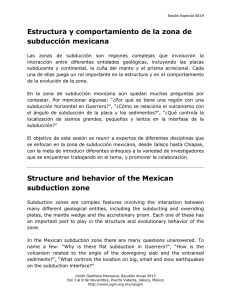
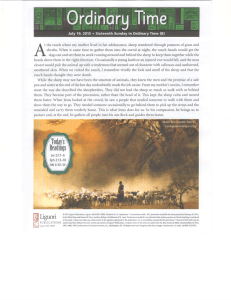
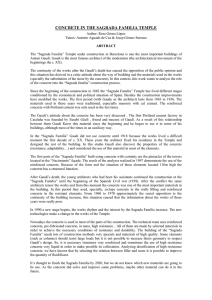
![LAZARILLO DE TORMES [1554] I. The picaresque novel: A very](http://s2.studylib.es/store/data/006112216_1-4e896eb1740cff4d986357429306ead6-300x300.png)
